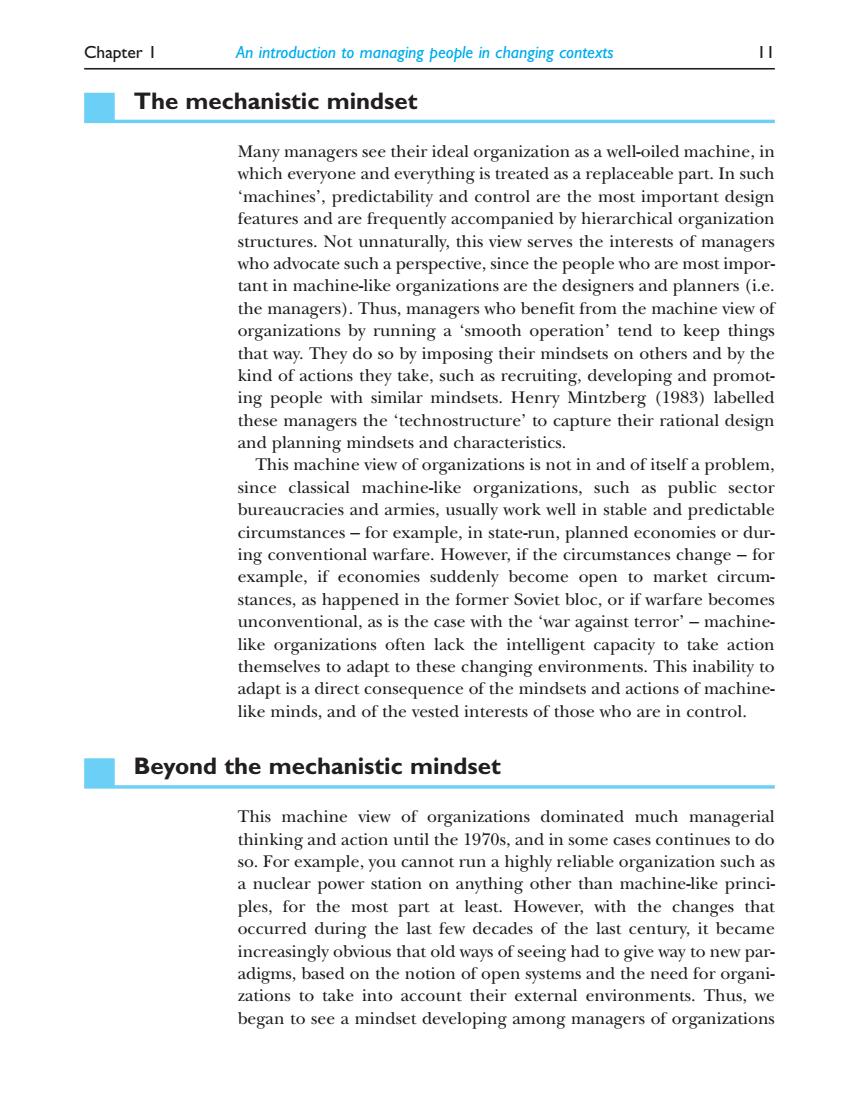正在加载图片...

Chapter l An introduction to managing people in changing contexts I川 The mechanistic mindset Many managers see their ideal organization as a well-oiled machine,in which everyone and everything is treated as a replaceable part.In such 'machines'.predictability and control are the most important design features and are frequently accompanied by hierarchical organization structures.Not unnaturally.this view serves the interests of managers who advocate such a perspective,since the people who are most impor- tant in machine-like organizations are the designers and planners(i.e the managers).Thus.managers who benefit from the machine view of organizations by running a 'smooth operation'tend to keep things that way.They do so by imposing their mindsets on others and by the kind of actions they take,such as recruiting,developing and promot- ing people with similar mindsets.Henry Mintzberg (1983)labelled these managers the 'technostructure'to capture their rational design and planning mindsets and characteristics. This machine view of organizations is not in and of itself a problem since classical machine-like organizations.such as public sector bureaucracies and armies,usually work well in stable and predictable circumstances- for example,in state-run,planned economies or dur- ing conventional warfare.However,if the circumstances change-for example,if economies suddenly become open to market circum stances,as happened in the former Soviet bloc,or if warfare becomes unconventional,as is the case with the 'war against terror'-machine like organizations often lack the intelligent capacity to take action themselves to adapt to these changing environments.This inability to adapt is a direct consequence of the mindsets and actions of machine- like minds,and of the vested interests of those who are in control. Beyond the mechanistic mindset This machine view of organizations dominated much managerial thinking and action until the 1970s,and in some cases continues to do so.For example,you cannot run a highly reliable organization such as a nuclear power station on anything other than machine-like princi- ples,for the most part at least.However,with the changes that occurred during the last few decades of the last century,it became increasingly obvious that old ways of seeing had to give way to new par adigms,based on the notion of open systems and the need for organi- zations to take into account their external environments.Thus,we began to see a mindset developing among managers of organizationsThe mechanistic mindset Many managers see their ideal organization as a well-oiled machine, in which everyone and everything is treated as a replaceable part. In such ‘machines’, predictability and control are the most important design features and are frequently accompanied by hierarchical organization structures. Not unnaturally, this view serves the interests of managers who advocate such a perspective, since the people who are most important in machine-like organizations are the designers and planners (i.e. the managers). Thus, managers who benefit from the machine view of organizations by running a ‘smooth operation’ tend to keep things that way. They do so by imposing their mindsets on others and by the kind of actions they take, such as recruiting, developing and promoting people with similar mindsets. Henry Mintzberg (1983) labelled these managers the ‘technostructure’ to capture their rational design and planning mindsets and characteristics. This machine view of organizations is not in and of itself a problem, since classical machine-like organizations, such as public sector bureaucracies and armies, usually work well in stable and predictable circumstances – for example, in state-run, planned economies or during conventional warfare. However, if the circumstances change – for example, if economies suddenly become open to market circumstances, as happened in the former Soviet bloc, or if warfare becomes unconventional, as is the case with the ‘war against terror’ – machinelike organizations often lack the intelligent capacity to take action themselves to adapt to these changing environments. This inability to adapt is a direct consequence of the mindsets and actions of machinelike minds, and of the vested interests of those who are in control. Beyond the mechanistic mindset This machine view of organizations dominated much managerial thinking and action until the 1970s, and in some cases continues to do so. For example, you cannot run a highly reliable organization such as a nuclear power station on anything other than machine-like principles, for the most part at least. However, with the changes that occurred during the last few decades of the last century, it became increasingly obvious that old ways of seeing had to give way to new paradigms, based on the notion of open systems and the need for organizations to take into account their external environments. Thus, we began to see a mindset developing among managers of organizations Chapter 1 An introduction to managing people in changing contexts 11